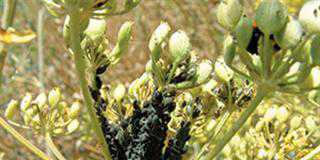
Farmers who are concerned with both profitability and sustainability should strive to reduce their reliance on farm chemicals, and instead enhance the natural resilience of their crops. The goal is to produce a plant with a strong immune system that requires less chemical intervention, benefiting the environment and the farmer’s bank account.
This is the opinion of Graeme Sait, CEO of Australian company Nutri-Tech Solutions (NTS). “Crop resilience is intimately related to the quality and yield of the crop,” says Sait. “There’s no substance that boosts plant immunity that does not also boost yield and crop quality. In this context, pursuing increased resilience is a win-win approach for the grower.
“However, there’s no magic bullet for achieving crop resilience.” Improving crop resilience involves an integrated five-pronged approach, which includes a combination of mineral management, biological inoculums, immune elicitors, photosynthesis enhancers, and a cell-strengthening strategy, he explains.
Mineral management
“No mineral is an island,” Sait emphasises. Every mineral antagonises or stimulates at least one other mineral if it is deficient or excessive. Maintaining the correct ratios is thus important to achieve maximum mineral availability.
The immune-boosting mineral management strategy begins with the calcium (Ca) to magnesium (Mg) ratio. This ratio is crucial, as it determines gas exchange. The more efficiently a soil can breathe, the healthier and more resilient the crop.
In light, sandy soils, the ratio should be 3:1 in favour of Ca, and in heavy, clay soils it should be 7:1 in favour of Ca. Other important resilience ratios include Mg to potassium (K), phosphorous (P) to zinc (Zn), and P to sulphur (S). Key ratios here include a 1:1 ratio between Mg and K. The P:Zn ratio should be 10:1, and the P:S ratio should be 1:1.
“The last three of these factors improve P delivery to the plant. P is the single- most important mineral for enhanced plant immunity.”
Reduce fungicide and fertiliser
According to Sait, P-based compounds are important in developing the flavour of fresh food. Unfortunately, frequent and sometimes unnecessary blanket applications of agro-chemicals prevent crops from experiencing natural disease challenges. The crops’ immune response is not elicited and this leads to bland flavour.
“Studies in Australia have also found that every fungicide we apply contributes to a yield decrease based on compromised plant immunity. Just as boosting immunity will boost yield, reducing immunity will limit yield,” he explains.
Applying too much N-based fertiliser can have a major negative impact on plant resilience. Nitrate N always enters plants with water, diluting plant nutrients. High levels of Nitrate N inevitably reduce mineralisation within the plant, which compromises the immune system and increases vulnerability to disease and insect attacks.
Sait stresses that N-based fertilisers should be applied to soil in strict accordance with an accurate soil and leaf analysis. A nitrate meter can be an invaluable tool for in-field monitoring to ensure that these levels remain within the correct parameters.
“There’s a critical 3:1 ratio between ammonium nitrogen and nitrate nitrogen in favour of ammonium nitrogen,” he says.
“It’s a big player in plant resilience and the best way to achieve it is to ensure access to free ammonium nitrogen from the atmosphere.”
A “free gift” of 74 000t of N gas hovers above every hectare. Farmers require five conditions to gain access to this:
- The correct Ca to Mg ratio
N-fixing organisms require an optimum flow of oxygen (O2) to operate efficiently. The Ca:Mg ratio determines gas exchange and the supply of all-important O2.
- An ongoing supply of soluble P
The only way to achieve this with a mineral that locks up so readily is to nurture the beneficial
fungi that solubilise locked-up P with the
acids they release.
Plant-available P is constantly required because it is the building block for adenosine triphosphate (ATP),
the primary source of energy for all enzymic reactions. N-fixation involves the enzyme nitrogenase which is fired by ATP.
- A sufficient quantity of molybdenum (Mo): Mo, which is part of the nitrogenase enzyme, was short in 85% of the leaf tests analysed by the NTS agronomy team. It is essential to test for this mineral in the soil and in the leaf. A minimum of 0,5ppm is required in the soil.
- An adequate level of iron (Fe): This mineral is also part of the nitrogenase enzyme. Fe is the most abundant mineral on the planet but is often called the ‘reluctant mineral’ because it can become unavailable in compacted soils and cold conditions. The trick here, according to Sait, is to apply humic acid as this increases the availability of Fe.
- A minimum of 2ppm of cobalt: Cobalt (Co), a crucial element, is often referred to as the ‘mother’s milk’ for N-fixing organisms.
Biological inoculums
Broad spectrum mineralisation of crops is another key for enhancing immune response and resilience.
“The first cell that oozed from the Precambrian ocean contained all 74 minerals, and nothing in nature is accidental,” says Sait.
He argues that most farmers address a little more than a dozen of these minerals, but there is benefit in a broad-spectrum approach. Natural sources of this range of minerals include anything from the ocean, he explains. Kelp and fish-based products boost resilience in the soil and in the plant, and are also highly effective, natural fertilisers.
At least five soil organisms are known to help plants enhance their resilience: Mycorrhizal fungi, Trichoderma, Pseudomonas fluorescens, Bacillus subtilis and Azotobacter.
- Mycorrhizal fungi
These produce substances that support plant immunity and help deliver P from the soil to plants. This is particularly important because P, along with Zn, are the two most immobile minerals in the soil.
- Trichoderma
This cellulose-digesting, humus building genus of fungi is effective at solubilising locked-up P in the soil. It promotes plant growth and produces protein-based immune supporters in plants. Trichoderma also kills 32 fungal pathogens. Unfortunately, it is often negatively affeceted by agro-chemicals, including those that contain copper.
- Pseudomonas fluorescens
These beneficial bacteria may be ubiquitous in healthy soils, but populations are seriously compromised when farmers apply glyphosate-based herbicides to their land. Its presence in soils supports many other beneficial soil life species, and soils short of it can be inoculated with products that contain them.
Sait advises that all microbial inoculums should be “sent off to work with a lunch box”. In this case, because bacteria are involved, he suggests that the lunch box should include fulvic acid and fish-based products to ensure a rapid colonisation of the new workforce.
“Pseudomonas fluorescens can also eat and out-compete the ice-nucleating bacteria responsible for the production of frost crystals in plants,” he says. “It’s a real surprise to most growers and consultants when they learn that frost is caused by micro-organisms and that it can be controlled biologically.”
- Bacillus subtilis
This forms a stable bio-film in the soil and secretes a biochemical called surfactin. These two actions combine to offer improved plant health.
B. subtilis also produces a substance called acetoin that has been found to trigger induced systemic resistance (ISR) to produce a more resilient plant. Sait says that inoculums of B. subtilis should also be fertigated or foliar-sprayed in conjunction with a combination of fulvic acid and fish emulsion to help them “hit the ground running”.
- Azotobacter
These free-living, N-fixing organisms can deliver over 20 kg/ha of N. They also produce biochemicals that help the plant protect itself. The key to achieving maximum results from Azotobacter inoculums is ensuring that they are applied in conjunction with Mo, Fe, Co and soluble P to provide the mineral tools needed for effective N-fixation.
Immune elicitors
“While beneficial organisms can stimulate immunity, there are also other strategies that can be valuable. Salicylic acid is a good example. This is a well-researched immune elicitor,” Sait says.
He explains that one of the reasons aloe vera is used as a foliar spray is that it contains the highest level of salicyclic acid of any plant. The nonsteroidal anti-inflammatory drug, aspirin, which is based on salicylic acid, can also be can be used at the appropriate rate as an immune elicitor.
“Another example of an effective immune elicitor is chitinase, which is derived from prawn shells. And research in New Zealand suggests that specific blends of essential oils can also be of value.”
Photosynthesis enhancers
According to Sait, chlorophyll management should be the main role of crop farmers everywhere. The greater the chlorophyll density in a plant, the higher its production and the greater its resilience. A refractometer can be used to monitor dissolved solids, or brix levels, in crop leaves. This is a guideline to chlorophyll density in a plant. The higher the brix level, the fewer the problems.
In this respect, the application of triacontanol can play an important role. Triacontanol is a substance found in the outer waxy coating of the lucerne plant and can also be sourced from the wax of bees working lucerne crops.
“It’s a natural plant growth promoter that, applied at 30ml/ha, has been shown to significantly increase crop yield. Benefits of applying triacontanol to plants also include increased growth rate, increased carbon dioxide (CO2) fixing, increased protein content, more flower buds, early maturity, and increased resilience,” says Sait.
Trials conducted by SK Ries in 1985 found that after plants were treated with triacontanol, their chlorophyll content increased by an average of 37%. A trial conducted by KKG Menon and HC Srivastava in 1984 found that maize seedlings treated with triacontanol fixed 43% more CO2 than the control did.
Increasing cell wall strength
A plant’s cell wall is the physical barrier against both disease-causing organisms and damage-causing insects. According to Sait, the two minerals that determine the strength of a cell wall are Ca and silicon (Si).
“Ca is the mineral that everyone struggles with. It’s extremely difficult to achieve ‘luxury’ levels of Ca in the plant leaf. This is because it has very poor mobility in the soil and plant.”He explains that there are five tricks for boosting Ca:
- Foliar-apply Ca with fulvic acid to boost Ca uptake by over 30%.
- Apply boron to the soil in late winter to trigger the release of Si in the soil. Si is the building block for the nutrient pathways phloem and xylem into and around the plant, allowing a plant to take up and process Ca more readily. Ca is the most immobile mineral, so improving pathways improves mobility.
- Apply water-soluble silica (potassium silicate) to the soil and plant, to boost nutrient transportation and translocation.
- Apply liquid micronised lime, with 44% Ca, via fertigation.
- Inoculate soils with mycorrhizal fungi and Trichoderma, as both organisms can break the bond between Ca and phosphate and make both minerals available to the plant.
Sait says that Si is often lacking in many of the soil tests his team reviews. A total of 100 ppm of soluble Si is the ideal concentration in soils. In addition to strengthening cell walls, Si boosts photosynthesis, protects plants from sodium and heavy metal toxicity and, most importantly, is a major immune elicitor.
“Potassium silicate can be applied via fertigation or foliar spray. It must be remembered, however, that it’s incompatible with almost all other liquid fertilisers, with the exception of fulvic acid and kelp.”
Diatomaceous earth
A more user-friendly source of Si is diatomaceous earth, explains Sait. “Diatoms are microscopic creatures that died millions of years ago, leaving only their silica-rich exoskeletons. When this diatomaceous earth is micronised down to five microns and held in liquid suspension, it can be applied to soils and crops in small amounts to achieve a significant increase in Si in plant leaves.”
- Email Graeme Sait at [email protected]. Visit www.nutri-tech.com.au.
- This presentation was given at a soil health seminar hosted by Zylem, which represents Nutri-Tech Solutions (Australia) and Brookside Laboratories Incorporated (US) in SA.
- For details on Nutri-Tech Solutions and Brookside Laboratories phone Zylem on 033 347 2893 or email [email protected].













